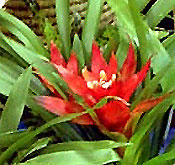Sunday, June 13, 2004
Latin names
I don't know about you, but I have a hard time remembering and/or identifying latin names of plants. This really came home to roost when I was searching a plant resource site and many of the plants did not have their common name posted, only the latin term. So, I got thinking. I'll bet I'm not the only person puzzled by a plant's latin nom de plume. There have got to be a few hundred others just like me who have to look things up unless it's a species we work with often.
Periodically I am going to feature a plant's latin name and common name and plan to build a little knowledge board on the information page of this site. So, my first pick is Guzmania lingulata. Now you may ask how I came up with that particular plant first. To tell you the truth, I randomly opened my plant encyclopedia and stuck my finger on the first name that popped out. So, Guzmania lingulata it is. What do we know about this plant? Well, it's a bromeliad. A tropical epiphyte, it grows naturally on tree branches by anchorage roots. Ok, what's an epiphyte you ask? According to our friend Webster, it is a plant that derives its moisture and nutrients from the air and rain and usually grows on another plant. Makes sense. Bromeliads form rosettes and produce what are thought to be beautiful blooms but are actually bracts that form a long spike. The spike eventually turns color and finally produces some inconsequential little flowers before it dies.
 Guzmania can be attached to trees using sphagnum moss wrapped around its roots or can be potted in a high humus soil that drains well. It needs warm, humid conditions to thrive and can be grown indoors with the proper attention. One thing I didn't know about bromeliads is that many are monocarpic, meaning that their rosettes flower only once and then die. But before they flower they form offsets around their base. These offsets can be planted but should not be removed until they're about 1/3 the size of the parent.
Guzmania can be attached to trees using sphagnum moss wrapped around its roots or can be potted in a high humus soil that drains well. It needs warm, humid conditions to thrive and can be grown indoors with the proper attention. One thing I didn't know about bromeliads is that many are monocarpic, meaning that their rosettes flower only once and then die. But before they flower they form offsets around their base. These offsets can be planted but should not be removed until they're about 1/3 the size of the parent.
Bromeliads are gorgeous plants so don't let the latin name intimidate you if you've never grown one. To find more details, visit the Bromeliad Society International.
Well, they say you learn something new every day and I know I just did. I'll share more latin terms frequently. Happy Gardening and watch out for that Oroya neoperuviana (cactus).
Periodically I am going to feature a plant's latin name and common name and plan to build a little knowledge board on the information page of this site. So, my first pick is Guzmania lingulata. Now you may ask how I came up with that particular plant first. To tell you the truth, I randomly opened my plant encyclopedia and stuck my finger on the first name that popped out. So, Guzmania lingulata it is. What do we know about this plant? Well, it's a bromeliad. A tropical epiphyte, it grows naturally on tree branches by anchorage roots. Ok, what's an epiphyte you ask? According to our friend Webster, it is a plant that derives its moisture and nutrients from the air and rain and usually grows on another plant. Makes sense. Bromeliads form rosettes and produce what are thought to be beautiful blooms but are actually bracts that form a long spike. The spike eventually turns color and finally produces some inconsequential little flowers before it dies.
 Guzmania can be attached to trees using sphagnum moss wrapped around its roots or can be potted in a high humus soil that drains well. It needs warm, humid conditions to thrive and can be grown indoors with the proper attention. One thing I didn't know about bromeliads is that many are monocarpic, meaning that their rosettes flower only once and then die. But before they flower they form offsets around their base. These offsets can be planted but should not be removed until they're about 1/3 the size of the parent.
Guzmania can be attached to trees using sphagnum moss wrapped around its roots or can be potted in a high humus soil that drains well. It needs warm, humid conditions to thrive and can be grown indoors with the proper attention. One thing I didn't know about bromeliads is that many are monocarpic, meaning that their rosettes flower only once and then die. But before they flower they form offsets around their base. These offsets can be planted but should not be removed until they're about 1/3 the size of the parent.
Bromeliads are gorgeous plants so don't let the latin name intimidate you if you've never grown one. To find more details, visit the Bromeliad Society International.
Well, they say you learn something new every day and I know I just did. I'll share more latin terms frequently. Happy Gardening and watch out for that Oroya neoperuviana (cactus).
Comments:
Post a Comment

This work is licensed under a Creative Commons License.
Thanks to Andrew Stenning who contributed the photograph for our masthead


